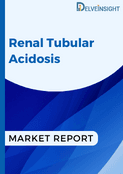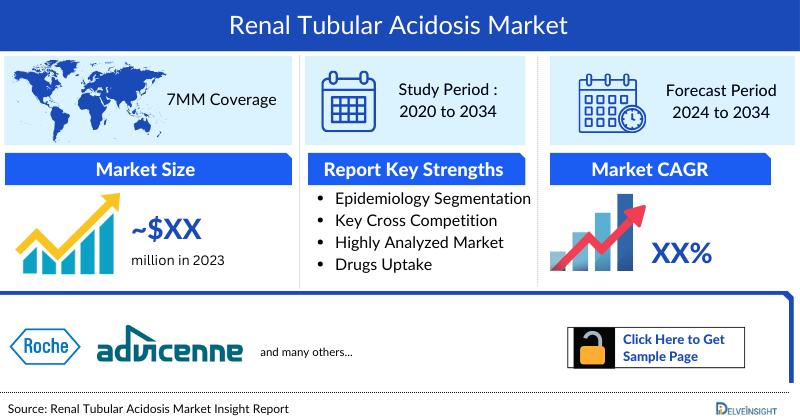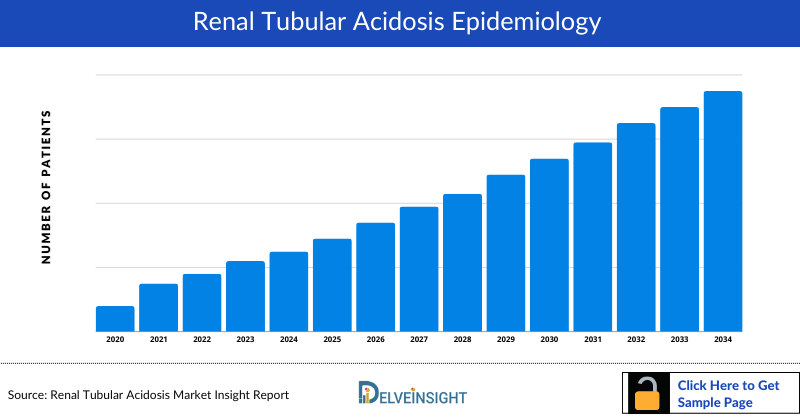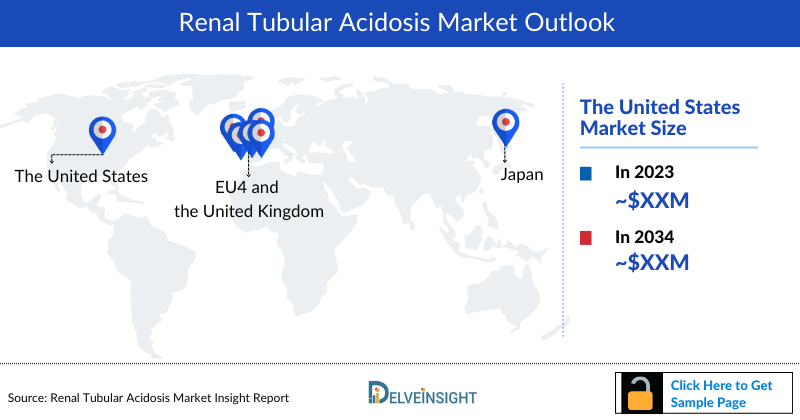Renal Tubular Acidosis Market Summary
- The Renal Tubular Acidosis Market focuses on managing a rare set of metabolic disorders characterized by impaired acid secretion or bicarbonate reabsorption in the renal tubules, leading to systemic metabolic acidosis.
- The leading Renal Tubular Acidosis Companies such as Hoffmann-La Roche, Advicenne and others.
Renal Tubular Acidosis Market Insights & Epidemiological Forecast
- According to DelveInsight's estimates, the United States led the 7MM in 2023, capturing approximately USD 13 million and holding the largest Renal Tubular Acidosis Market Share.
- Renal Tubular Acidosis (RTA) refers to a group of disorders in which the kidneys fail to properly remove acids from the blood, leading to an accumulation of acid in the bloodstream. This disruption in acid-base balance is the primary cause of acidosis, where the blood becomes overly acidic. RTA is caused by defects in the renal tubules, which impair their ability to maintain the body’s acid-base equilibrium.
- In 2023, approximately 112,000 cases of Renal Tubular Acidosis were recorded across the seven major markets (7MM), with the United States accounting for the largest share, representing about 43% of the total cases.
- In 2023, out of the 25% of Renal Tubular Acidosis Diagnosed Cases in the United States, approximately 52% of these cases were found in females.
- In 2023, the prevalence of Type 1 Distal Renal Tubular Acidosis (dRTA) was significantly higher compared to other forms of Renal Tubular Acidosis, such as Type 2 proximal Renal Tubular Acidosis (pRTA), Type 3 mixed Renal Tubular Acidosis, or Type 4 hyporeninemic hypoaldosteronism. Specifically, Type 1 dRTA accounted for approximately 45% of cases in the United States.
- There are no approved therapies or significant clinical developments for Renal Tubular Acidosis (RTA). Current treatment focuses on managing the condition with oral sodium bicarbonate or potassium citrate for Type 1 dRTA, bicarbonate or citrate supplements for Type 2 pRTA, and mineralocorticoid replacements for Type 4 hyporeninemic hypoaldosteronism. This gap in new therapies underscores the need for continued research and innovation.
Request for Unlocking the Sample Page of the "Renal Tubular Acidosis Treatment Market"
Key Factors Driving Renal Tubular Acidosis Myeloma Market Growth
-
Rising Disease Understanding in Myeloma-Associated RTA
Growing recognition of renal tubule dysfunction as a significant complication of multiple myeloma is improving diagnosis rates, expanding the treatable population, and driving disease management efforts.
-
Increasing Myeloma Incidence and Improved Patient Survival
As survival improves due to advanced myeloma therapies, the prevalence of chronic complications such as RTA increases, fueling demand for long-term renal management options.
-
Better Clinical Diagnostics and Monitoring Tools
Enhanced availability of biochemical and imaging diagnostics for electrolyte imbalance and renal metabolic acidosis supports earlier detection and timely treatment interventions.
-
Expanding Research on Renal Complications in Cancer
Increasing research into tubule pathophysiology and protein overload mechanisms in myeloma opens new therapeutic targets, helping accelerate clinical pipeline momentum.
-
Growing Use of Supportive Care and Nephrology Management
Adoption of supportive management including bicarbonate therapy, potassium supplements, and correction of electrolyte imbalance boosts overall market prospects.
-
Hospital and Specialty Clinic Awareness Initiatives
Enhanced physician education on RTA in oncology settings reduces underdiagnosis and leads to better treatment utilization.
-
Potential Entry of Targeted Renal Therapeutics
Future candidates specifically aimed at correcting renal tubular function or blocking tubular injury pathways could reshape treatment approaches, supporting long-term market expansion.
DelveInsight's “Renal Tubular Acidosis Market Insights, Epidemiology and Market Forecast – 2034” report delivers an in-depth understanding of the indication Renal Tubular Acidosis, historical and forecasted epidemiology as well as the Renal Tubular Acidosis market trends in the United States, EU4 (Germany, Spain, Italy, and France) and the United Kingdom, and Japan.
The Renal Tubular Acidosis Treatment Market Report provides real-world prescription pattern analysis, approved drugs, market share of individual therapies, and historical and forecasted 7MM Renal Tubular Acidosis market size from 2020 to 2034. The report also covers current Renal Tubular Acidosis treatment practices/algorithms and unmet medical needs to curate the best opportunities and assess the market’s underlying potential.
Scope of the Renal Tubular Acidosis Market | |
|
Study Period |
2020–2034 |
|
Forecast Period |
2024–2034 |
|
Geographies Covered |
|
|
Renal Tubular Acidosis Epidemiology
|
Segmented by:
|
|
Renal Tubular Acidosis Market |
Segmented By:
|
|
Analysis |
|
Renal Tubular Acidosis Treatment Market: Understanding and Algorithm
Country-Specific Treatment Guidelines and Diagnosis
Renal Tubular Acidosis (RTA) is a rare disorder where the kidneys are unable to efficiently excrete acids into the urine, leading to an accumulation of acid in the bloodstream, a condition known as acidosis. Unlike other forms of acidosis associated with kidney failure, RTA occurs even when the kidney's filtering function remains normal or near-normal. The condition is categorized into four main types. Type 1 (Distal RTA) results from a defect in acid secretion in the distal tubules, while Type 2 (Proximal RTA) is due to impaired bicarbonate reabsorption in the proximal tubules. Type 3, though rarely used, is considered a combination of Type 1 and Type 2. Type 4 RTA is associated with hyperkalemia (elevated potassium levels) and impaired function of the distal tubules.
Renal Tubular Acidosis Diagnosis involves a combination of clinical evaluation, blood tests, and urine tests. Blood tests help measure levels of bicarbonate, blood pH, and potassium, where a low bicarbonate level and acidosis suggest RTA. Urine tests assess urine pH and the presence of electrolytes, and a high urine pH with low blood bicarbonate levels can indicate Type 1 or 2 RTA. The ammonium chloride loading test may also be used to evaluate the kidney's ability to acidify urine. Additionally, serum and urine electrolyte measurements help differentiate between the types of RTA and assess the body's overall acid-base balance. In some cases, imaging studies and genetic testing may be necessary, particularly for hereditary forms of RTA. Early diagnosis is essential to prevent complications such as growth retardation in children, kidney stones, and chronic kidney disease.
Further details related to country-based variations in diagnosis are provided in the report
Renal Tubular Acidosis Treatment
The management of Renal Tubular Acidosis (RTA) encompasses a variety of treatment strategies tailored to each specific type of the condition. Current approaches focus on addressing the underlying acid-base imbalances and electrolyte disturbances characteristic of RTA.
- Type 1 Distal RTA (dRTA): Treated with oral sodium bicarbonate or potassium citrate for metabolic acidosis and potassium supplements for hypokalemia. Emerging treatments include improved sodium bicarbonate formulations and novel potassium-sparing diuretics.
- Type 2 Proximal RTA (pRTA): Managed with bicarbonate or citrate supplements and potassium supplements. Thiazide diuretics may help with bicarbonate loss. Emerging treatments include SGLT2 inhibitors.
- Type 3 Mixed RTA: Combines treatments for Type 1 and Type 2 RTA, with new custom formulations being developed.
- Type 4 Hyporeninemic Hypo aldosteronism: Treated with mineralocorticoid replacements like fludrocortisone and potassium binders. Research is ongoing into new aldosterone antagonists.
Renal Tubular Acidosis Epidemiology Segmentation in the 7MM
The Renal Tubular Acidosis epidemiology chapter in the report provides historical as well as forecasted Renal Tubular Acidosis Prevalence in the 7MM covering the United States, EU4 countries (Germany, France, Italy, and Spain), the United Kingdom, and Japan from 2024 to 2034.
- Renal Tubular Acidosis Diagnosed Prevalent Cases
- Renal Tubular Acidosis Type-specific Cases
- Renal Tubular Acidosis Age-specific Cases
- Renal Tubular Acidosis Cases by Types
- Renal Tubular Acidosis Gender-specific Cases
Key findings from the Renal Tubular Acidosis Epidemiological Analysis
- In 2023, approximately 112,000 cases of Renal Tubular Acidosis (RTA) were recorded across the seven major markets (7MM), with the United States accounting for the largest share, representing about 43% of the total cases. These cases might rise by 2034 at a CAGR of XX%.
- EU4 and the UK, accounted for approximately 40% of the total prevalent cases of Renal Tubular Acidosis in the year 2023.
- In 2023, out of the 25% of diagnosed Renal Tubular Acidosis cases in the United States, approximately 52% of these cases were found in females.
- In 2023, the prevalence of Type 1 distal Renal Tubular Acidosis (dRTA) was significantly higher compared to other forms of Renal Tubular Acidosis, such as Type 2 proximal Renal Tubular Acidosis (pRTA), Type 3 mixed Renal Tubular Acidosis, or Type 4 hyporeninemic hypoaldosteronism. Specifically, Type 1 dRTA accounted for approximately 45% of cases in the United States.
- The Renal Tubular Acidosis Prevalence was notably higher among adult individuals, contributing approximately 60% of the patient population in 2023.
Renal Tubular Acidosis Market Outlook
The market for Renal Tubular Acidosis (RTA) treatments is currently characterized by a diverse range of established therapies and a notable lack of pipeline drugs or recently approved treatments. This absence of new entrants underscores a significant opportunity for innovation within the field. As the market is primarily occupied by established drugs like oral citrates, and off-label treatments, there is a substantial gap for novel therapies and improved formulations. This void presents a prime space for pharmaceutical companies and research institutions to drive advancements, develop new treatment options, and address unmet needs in the management of RTA.
Renal Tubular Acidosis Drugs Uptake
This section focuses on the uptake rate of potential Renal Tubular Acidosis drugs expected to be launched in the market during 2024–2034, which depends on the competitive landscape, safety, and efficacy data along with order of entry. It is important to understand that the key players evaluating their novel therapies in the pivotal and confirmatory trials should remain vigilant when selecting appropriate comparators to stand the greatest chance of a positive opinion from regulatory bodies, leading to approval, smooth launch, and rapid uptake.
Renal Tubular Acidosis Pipeline Development Activities
This section provides insights into different therapeutic candidates. It also analyzes key Renal Tubular Acidosis Companies involved in developing targeted therapeutics. This section covers information on collaborations, acquisitions and mergers, licensing, and patent details for emerging therapies.
Latest KOL Views on Renal Tubular Acidosis
To keep up with the real-world scenario in current market trends, we take opinions from Key Industry leaders working in the domain through primary research to fill the data gaps and validate our secondary research. Industry Experts were contacted for insights on the evolving treatment landscape, patient reliance on conventional therapies, patient therapy switching acceptability, and drug uptake along with challenges related to accessibility. DelveInsight’s analysts connected with 10+ KOLs to gather insights; however, interviews were conducted with 5+ KOLs in the 7MM. Their opinion helps understand and validate current treatment patterns of Renal Tubular Acidosis. This will support the clients in potential upcoming novel treatments by identifying the overall scenario of the market and the unmet needs.
Renal Tubular Acidosis Qualitative Analysis Report
We perform Qualitative and market Intelligence analysis using various approaches, such as SWOT analysis and Conjoint Analysis. In the SWOT analysis, strengths, weaknesses, opportunities, and threats in terms of gaps in disease diagnosis, patient awareness, physician acceptability, competitive landscape, cost-effectiveness, and geographical accessibility of therapies are provided. Conjoint Analysis analyzes multiple approved therapies based on relevant attributes such as safety, efficacy, frequency of administration, route of administration, and order of entry. Scoring is given based on these parameters to analyze the effectiveness of therapy.
In efficacy, the trial’s primary and secondary outcome measures are evaluated; for instance, in event-free survival, one of the most important primary outcome measures is event-free survival and overall survival. Further, the therapies’ safety is evaluated wherein the acceptability, tolerability, and adverse events are majorly observed, and it sets a clear understanding of the side effects posed by the drug in the trials. In addition, the scoring is also based on the probability of success, and the addressable patient pool for each therapy.
Renal Tubular Acidosis Therapeutics Market Access and Reimbursement
The section provides detailed insights on the country-wise accessibility and reimbursement scenarios, cost-effectiveness scenario of currently used therapies, programs making accessibility easier and out-of-pocket costs more affordable, insights on patients insured under federal or state government prescription drug programs, etc.
Renal Tubular Acidosis Therapeutics Market Report Scope
- The Renal Tubular Acidosis Therapeutics Market Report covers a segment of key events, an executive summary, descriptive overview, explaining its causes, signs and symptoms, pathogenesis, and currently available therapies.
- Comprehensive insight has been provided into the epidemiology segments and forecasts, the future growth potential of diagnosis rate, and disease progression along with country specific treatment guidelines.
- Additionally, an all-inclusive account of the current therapies, along with the elaborative profiles of late-stage and prominent therapies, will have an impact on the current treatment landscape.
- A detailed review of the Renal Tubular Acidosis Treatment Market, historical and forecasted Renal Tubular Acidosis Treatment Market Size, Renal Tubular Acidosis Drugs Market Share by therapies, detailed assumptions, and rationale behind our approach is included in the report, covering the 7MM drug outreach.
- The Renal Tubular Acidosis Therapeutics Market Report provides an edge while developing business strategies, by understanding trends, through SWOT analysis and expert insights/KOL views, patient journey, and treatment preferences that help in shaping and driving the 7MM Renal Tubular Acidosis.
Renal Tubular Acidosis Therapeutics Market Report Insights
- Patient-based Renal Tubular Acidosis Market Forecasting
- Therapeutic Approaches
- Renal Tubular Acidosis Pipeline Drugs Analysis
- Renal Tubular Acidosis Market Size and Trends
- Existing and future Renal Tubular Acidosis Drugs Market Opportunity
Renal Tubular Acidosis Therapeutics Market Report Key Strengths
- 11 Years Renal Tubular Acidosis Market Forecast
- 7MM Coverage
- Renal Tubular Acidosis Epidemiology Segmentation
- Inclusion of Country specific treatment guidelines
- KOL’s feedback on approved therapies
- Key Cross Competition
- Conjoint analysis
- Renal Tubular Acidosis Drugs Uptake
- Key Renal Tubular Acidosis Market Forecast Assumptions
Renal Tubular Acidosis Therapeutics Market Report Assessment
- Current Renal Tubular Acidosis Treatment Market Practices
- Renal Tubular Acidosis Unmet Needs
- Renal Tubular Acidosis Pipeline Drugs Profiles
- Renal Tubular Acidosis Drugs Market Attractiveness
- Qualitative Analysis (SWOT and Conjoint Analysis)
Key Questions Answered in the Renal Tubular Acidosis Market Report
- What is the growth rate of the 7MM Renal Tubular Acidosis treatment market?
- What was the Renal Tubular Acidosis Treatment market size, the market size by therapies, Renal Tubular Acidosis Drugs Market Share (%) distribution in 2020, and what would it look like in 2034? What are the contributing factors/key catalysts for this growth?
- Is there any unexplored patient setting that can open the window for growth in the future?
- What are the pricing variations among different geographies for approved and off-label therapies?
- How would the market drivers, barriers, and future opportunities affect the market dynamics and subsequent analysis of the associated trends?
- What are the current options for the treatment of Renal Tubular Acidosis?
- What are the recent novel therapies, targets, Renal Tubular Acidosis Mechanisms of Action, and technologies developed to overcome the limitations of existing therapies?
- Patient acceptability in terms of preferred treatment options as per real-world scenarios?
- What are the country-specific accessibility issues of expensive, recently approved therapies?
Reasons to Buy the Renal Tubular Acidosis Market Report
- The Renal Tubular Acidosis Therapeutics Market Report will help in developing business strategies by understanding the latest trends and changing treatment dynamics driving the Renal Tubular Acidosis Drugs Market.
- Insights on patient burden/disease Renal Tubular Acidosis Prevalence, evolution in diagnosis, and factors contributing to the change in the epidemiology of the disease during the forecast years
- Understand the existing Renal Tubular Acidosis Drugs Market opportunities in varying geographies and the growth potential over the coming years.
- Distribution of historical and current patient share based on real-world prescription data along with reported sales of approved products in the US, EU4 (Germany, France, Italy, and Spain), the United Kingdom, and Japan.
- Detailed analysis and ranking of class-wise potential current therapies under the conjoint analysis section to provide visibility around leading classes.
- Highlights of access and reimbursement policies of approved therapies, barriers to accessibility of expensive off-label therapies, and patient assistance programs.
- To understand Key Opinion Leaders’ perspectives around the accessibility, acceptability, and compliance-related challenges of existing treatment to overcome barriers in the future.
Stay Updated with us for Recent Articles




